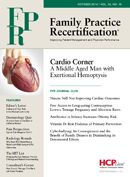Publication
Article
Family Practice Recertification
Cyberbullying: Its Consequences and the Benefit of Family Dinners in Diminishing its Detrimental Effects
Author(s):
Can a family dinner help fight cyberbullying? A recent study asked just that question.

Frank J. Domino, MD
Review
Elgar, F. et al. “Cyberbullying Victimization and Mental Health in Adolescents and the Moderating Role of Family Dinners 2014.” Dly:10.1001/ JAMA Pediatrics 2014.1223.
Cyberbullying results in internal and external problems for adolescents and is highly associated with substance abuse. This study evaluates t the impact of cyberbullying on adolescent mental health and explores a possible moderating role of family contact in this regard.
Study Methods
This was a cross-sectional observational study using survey methods of 18,000 students aged 12 to 18 years. Students were culled from 49 schools in the Midwest. Students were queried about the frequency of cyberbullying during the previous 12 months as well as being victim of traditional, or face- to- face, bullying, and the perpetration of traditional bullying.
The survey was voluntary, anonymous, and administered electronically at school. Parental consent was waived by notifying parents 4 weeks in advance of the survey, inviting them to review the survey, and allowing them to opt out. More than 90% of the students in the districts being studied participated. Of the 20,385 initial students covered in this survey, 1,555 cases, approximately 7% of the sample, were unavailable for evaluation. Their removal from the final dataset did not change the composition or statistical relevance of the outcomes.
Just over half of the studied participants were female. Seventy percent of the population studied was white, 7.6% black, 6.6% Hispanic, and 7% mixed, with the remaining 8.8% Asian, Native American, Middle Eastern, or other. Approximately 25% of the sample studied qualified for free or reduced cost lunch while at school.
The survey tool asked “in the past 12 months how often have you been bullied, threatened, or harassed through the internet or text messaging” to be graded on a scale of never, rarely, sometimes, or often. For face- to- face bullying the “bullying and victimization subscales” of the University of Illinois Aggression Scale was used to determine the occurrence of face to face bullying. This subscale contains 6 items that measured the frequency of harassing, upsetting, or making fun of other students, spreading rumors, starting arguments, or socially excluding others on a scale of 0 for never, 1 for 1-2 times, 2 for 3-4 times, and 3 for ≥ 5 times. The victimization subscale contained 4 items that measured the frequency of being picked on, made fun of, called names, and hit or pushed by other students with the scale again being 0 for never, 1 for 1-2 times, 2 for 3-4 times, and 3 for ≥ 5 times.
The survey also attempted to measure the influence of eating dinner as a family. It questioned “in the average week how many days do you eat evening meals with your family” on a scale of 0-7. The frequency of family dinners was used as a marker based upon prior studies demonstrating family dinners having an influence on adolescent mental health.
Other factors studied in the survey were age, gender, and qualification for a free or reduced lunch which was an indicator of household income.
Results
Just under one in 5 students of the survey reported being cyberbullied in the previous 12 months. Those who were frequently bullied correlated highly with all 11 mental health and substance abuse issues. This included 5 “internalizing mental health problems” (anxiety, depression, self-harm, suicidal ideation, and suicide attempt) as well as “externalizing problems” (fighting and vandalism), and 4 substance abuse problems (frequent alcohol use, frequent binge drinking, prescription drug misuse, and over the counter drug misuse).
The areas of highest predictive probability were cyberbullying inducing an increased risk for physical fighting, vandalism, anxiety, depression, self-harm, and suicidal thoughts. When more detailed analysis was applied, gender played a role. Girls reported lower rates of externalizing problems when bullied and higher rates of internalizing problems as well as substance abuse. Age correlated with the rate of substance use problems whereas low household income and perpetuation of face to face bullying positively related to all problem areas. Being victimized by face-to- face bullying increased the rates of internalizing and externalizing problems, but not substance abuse.
What was most striking was the influence of family dinners on the rates of internalizing, externalizing, and substance abuse issues as well as total problems. In each area, health disparities across levels of victimization tended to decrease as family dinners increased. This study compared extremes of 0 dinners per week to 4 dinners per week. The latter correlated with a 4-fold reduction in the rates of total problems.
Conclusion
Cyberbullying occurs in a significant percentage of the adolescent population. It results in increased risk in mental health issues as well as substance use problems in adolescents. This data supports the protective benefit of frequent family dinners (as a proxy for family contact and communication).
Discussion
Cyberbullying is a common occurrence during adolescence, affecting one in 5 adolescents. Because it is not physically threatening, its adverse effects tend to be psychological. This occurring during an already volatile time in a person’s emotional development makes it all the more distressing. An interesting finding was the influence that gender played with girls more likely to experience cyberbullying than boys who traditionally have been the focus of face- to- face bullying.
This study evaluated family dinners as a proxy for communication. It found as the frequency of cyberbullying increased so did the beneficial effects of frequent family dinners. In addition to ensuring regular family contact and a forum for adolescents to bring up issues and problems as they arise, frequent family dinners are felt to provide benefit by facilitating open communication within the family and timely parental guidance and support.
When analyzing a health problem, family physicians strive to focus on what can be done to prevent or treat it. This study gives us such a tool.
When parents ask, “What can I do?” the answer is relatively simple and straightforward: Gather around the table and eat together.
About the Author
Frank J. Domino, MD, is Professor and Pre-Doctoral Education Director for the Department of Family Medicine and Community Health at the University of Massachusetts Medical School in Worcester, MA. Domino is Editor-in-Chief of the 5-Minute Clinical Consult series (Lippincott Williams & Wilkins).
Additionally, he is Co-Author and Editor of the Epocrates LAB database, and author and editor to the MedPearls smartphone app. He presents nationally for the American Academy of Family Medicine and serves as the Family Physician Representative to the Harvard Medical School’s Continuing Education Committee.






